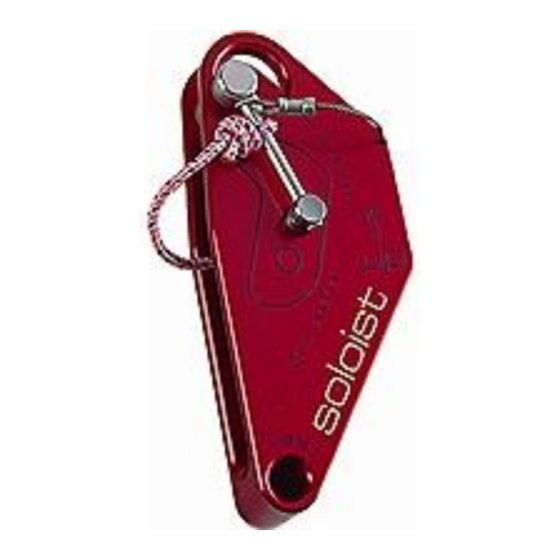
Advertisement
LEADING
Try leading a few easy routes at first to get used to the feel of the Soloist.
Remember that if you are bothered by drag, you can easily eliminate it (figure
6). Take a few small falls on bombproof protection just for fun (falls can be
fun?).
While leading, you'll want to be aware of where the rope is below you, so that
in a fall, it won't get tangled around your legs, which would prevent the jaw
from locking. Also, with any solo belay method there will be two parts of the
rope hanging from you, the anchored side and the free side (plus the rope
hanging from the backup knot if it's attached to you). Make sure you clip the
anchored side into your protection.
Soloist
Solo Belay System
Instruction Manual
Manufactured by:
Rock Exotica Equipment
P.O. Box 160470 Clearfield, UT 84016
Phone: 801-728-0630 Fax: 801-728-0667
www.rockexotica.com
Rock Exotica Equipment makes no express warranties concerning the
Soloist. This product is solely for use in recreational climbing and
mountaineering, following the specific guidelines of the User's Manual.
Advertisement
Table of Contents

Summary of Contents for ROCK EXOTICA Soloist
- Page 1 Soloist LEADING Try leading a few easy routes at first to get used to the feel of the Soloist. Remember that if you are bothered by drag, you can easily eliminate it (figure 6). Take a few small falls on bombproof protection just for fun (falls can be Solo Belay System fun?).
- Page 2 Soloist). It doesn’t matter if the jaw and pin are in the Soloist or left out. it is easy to back up.
- Page 3 Climb up a few feet (take up the slack by pulling on the side of the rope that comes out the top of the Soloist) and tie a backup knot. Now . . . JUMP! Assuming that the laws of physics are in effect, you won’t go far. Climb up a few more feet, but this time leave some slack in the rope and jump again.
- Page 4 Or, you can coil the free the angle that the rope comes out of the Soloist. It will not lock if you fall side of the rope or put it in a stuff sack, and take the whole thing with you, headfirst.
- Page 5 4) Falling on the Soloist BASIC OPERATION To see how the Soloist works, put the rope through it and pull on the end that comes out of the bottom (figure 3). If you pull down on the rope, it will travel freely through the Soloist, but an upward pull will cause the jaw to lock, preventing rope travel.
- Page 6 RAPPELLING some drag, but relieving the weight is very fast and simple, and allows you to The slot on the bottom of the Soloist can be used for rappelling on a single solo any route without drag. rope. To do so, just push a loop of rope through it and clip a ‘biner (or two, for more friction) through the loop as you would with a belay plate.




Need help?
Do you have a question about the Soloist and is the answer not in the manual?
Questions and answers